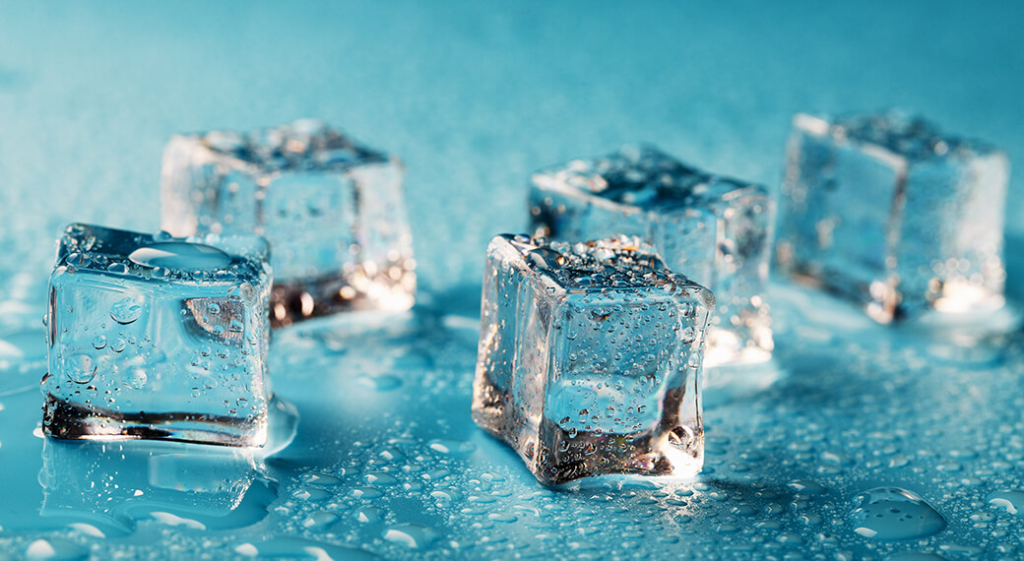Understanding the ins and outs of different types of ice is a necessity for foodservice teams who want to serve truly fantastic drinks, keep food perfectly fresh, and provide a pleasant experience for their guests. Knowing the ins and outs of ice also ensures a much smoother operation, protecting equipment and making the most of valuable resources!
Below is a guide to the most common types of ice used in the restaurant and foodservice industry and how their shape influences their function.
Cubes
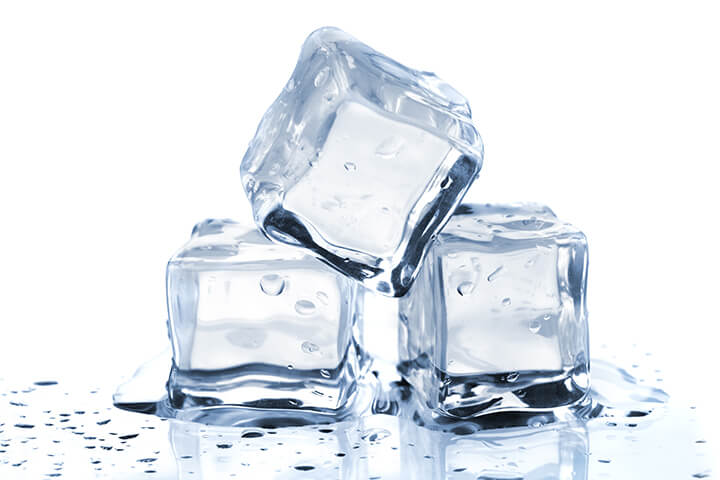
The two cube sizes used the most in foodservice are full and half.
Distinguished by its larger size and solid structure, full cube ice offers maximum cooling capacity while exhibiting the slowest melt rate among standard cubes. A slow melt rate is particularly advantageous because it minimizes the dilution of beverages and contributes to cost savings by reducing overall ice consumption. Consequently, full cubes are ideally suited for applications such as bagging and dispensing, as well as for serving in soft drinks and mixed drinks.
- Key Characteristics: Large, solid, slow melt rate, maximum cooling
- Common Uses in Foodservice: Bagging, dispensing, soft drinks, mixed drinks
- Ideal Applications: Beverages where minimal dilution is desired, high-volume ice needs
As its name suggests, half cube ice is approximately half the size of a full cube. Its reduced size results in a faster cooling rate compared to full cubes due to an increased surface area. Half cubes provide effective cooling for a wide range of beverages without causing excessively rapid dilution. Its size also makes it well-suited for self-service dispensing and for use in blenders for preparing smoothies and frozen concoctions.
- Key Characteristics: Large, solid, slow melt rate, maximum cooling
- Common Uses in Foodservice: Soft drinks, mixed drinks, frozen cocktails, self-service dispensing, smoothies
- Ideal Applications: Versatile use across various beverage types
Nugget Ice
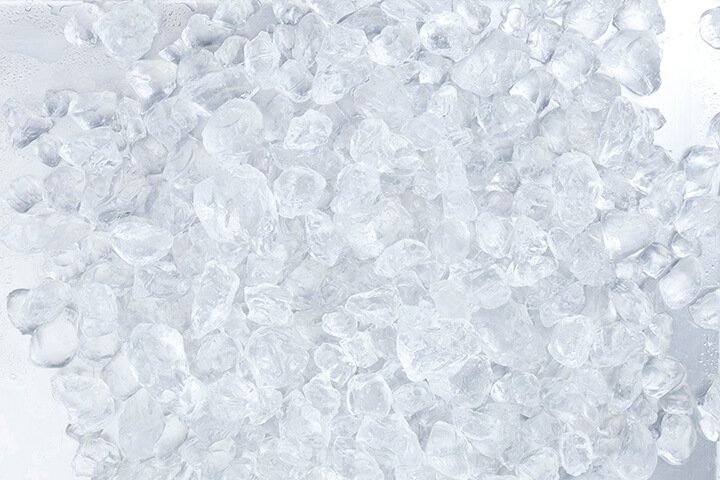
This distinct type of ice is characterized by its soft and chewable texture. Its porous composition allows it to cool beverages quickly and readily absorb the flavors of the drinks it accompanies. This texture and flavor absorption contributes to its significant popularity among consumers who appreciate the enjoyable “mouthfeel” and chewability.
Nugget ice is known by various names, including pebble ice, pellet ice, soft ice, and cubelet ice (often associated with the brand Hoshizaki.) Its applications are widespread across different foodservice segments, including healthcare facilities (where its soft texture is particularly beneficial for patients), restaurants, bars, and convenience stores. Nugget ice is particularly favored for soft drinks and performs exceptionally well in blended cocktails like margaritas and daiquiris.
- Key Characteristics: Soft, chewable, porous, rapid cooling, absorbs flavors
- Common Uses in Foodservice: Soft drinks, blended drinks, healthcare facilities
- Ideal Applications: Beverages where chewability and flavor absorption are desired
Flake Ice

Distinguished by its soft, snow-like, and easily moldable consistency, flake ice resembles compressed snow with irregularly shaped pieces. It possesses a high surface area, resulting in a relatively quick melting rate and a 73% ice-to-water ratio. Its primary application lies in maintaining the freshness and visual appeal of delicate food items. Flake ice is commonly used in supermarket displays for seafood and produce, as well as in food transport, where its soft texture prevents bruising and helps maintain optimal temperatures.
From an operational perspective, flake ice is considered the most economical type of ice to produce. While not primarily intended for standard beverage service, its role in food preservation and display makes it an indispensable ice type for certain segments of the foodservice industry.
- Key Characteristics: Soft, snow-like, moldable, rapid cooling, 73% ice-to-water ratio
- Common Uses in Foodservice: Food displays, blended drinks
- Ideal Applications: Maintaining freshness and visual appeal of perishable items
Crescent Ice
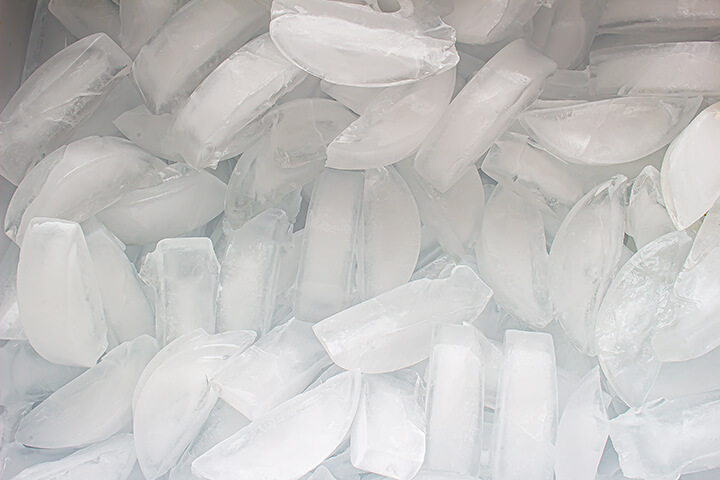
Characterized by its distinctive half-moon or curved shape and solid structure, crescent ice offers a combination of functionality and presentation. Its shape allows it to move freely within a glass without packing tightly together. This characteristic also contributes to a reduction in splashing when pouring or drinking. Crescent ice is commonly used in a variety of foodservice settings, including commercial kitchens, bars, and convenience stores. Its melt rate is generally considered to be moderate to slow, providing a good balance between cooling the beverage and minimizing excessive dilution.
- Key Characteristics: Half-moon shape, solid, moderate to slow melt rate
- Common Uses in Foodservice: Soft drinks, mixed drinks, general beverage service
- Ideal Applications: Efficient liquid displacement, reducing splashing
Crushed Ice
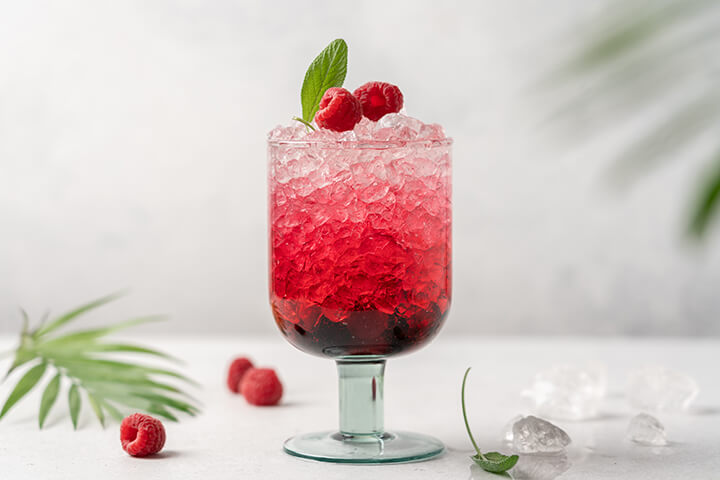
Consisting of small, irregular fragments of ice, crushed ice offers rapid chilling of beverages due to its large surface area. It is essential for creating blended cocktails like frozen margaritas, daiquiris, and piña coladas, as well as for serving drinks like Mint Juleps where a slushy consistency or significant dilution is desired. The texture provided by crushed ice is a key element of these specific drink styles.
- Key Characteristics: Small, irregular pieces, rapid chilling
- Common Uses in Foodservice: Blended cocktails, Mint Juleps
- Ideal Applications: Drinks requiring a slushy texture or rapid cooling
Spherical Ice

Perfectly round balls of ice, sphere ice melts very slowly due to its minimal surface area to volume ratio. This slow melt rate makes it ideal for serving straight spirits like whiskey or scotch “on the rocks” or in spirit-forward cocktails such as an Old Fashioned or Negroni, where minimal dilution is desired. Sphere ice‘s elegant appearance also enhances the presentation of these drinks and adds special elements of fun and creativity.
- Key Characteristics: Perfectly round, melts very slowly
- Common Uses in Foodservice: Straight spirits, spirit-forward cocktails
- Ideal Applications: Minimizing dilution of premium spirits, enhancing presentation
Collins Spears

These long, thick, rectangular blocks of ice are specifically designed for use in tall, narrow highball or Collins glasses, commonly used for cocktails like Tom Collins, gin and tonics, or Mojitos. They melt slowly, ensuring minimal dilution while keeping the entire drink in the tall glass cold from top to bottom. The shape and size are optimized for this specific glassware and cocktail type.
- Key Characteristics: Long, rectangular block, slow melt rate
- Common Uses in Foodservice: Highball/Collins glasses
- Ideal Applications: Maintaining temperature and minimizing dilution in tall cocktails
Misc. Shapes
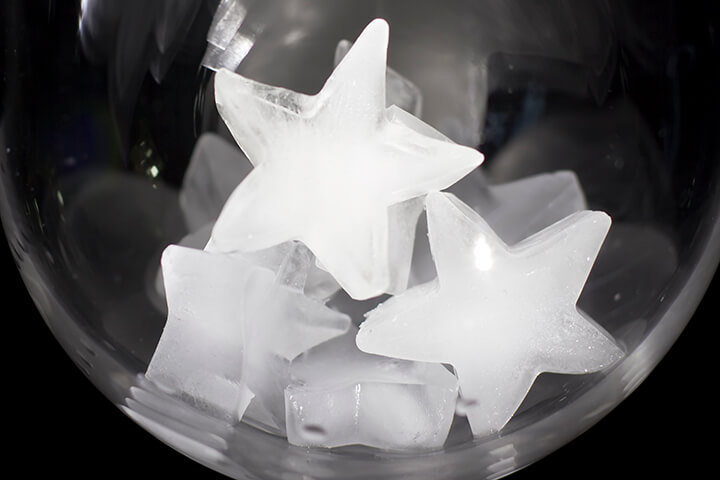
The foodservice industry also sees the use of other less common but visually distinctive specialty ice shapes, including top hat ice, octagonal cubes, diamond shapes, and even custom-designed ice featuring embedded logos or garnishes. These often fall under the umbrella of gourmet or craft ice and are primarily employed to enhance the aesthetic appeal of beverages.
- Key Characteristics: Unique forms
- Common Uses in Foodservice: Specialty cocktails, branding opportunities
- Ideal Applications: Enhancing visual appeal, memorable beverages
Choosing the Perfect Ice for Every Foodservice Need
For any foodservice expert, understanding the varieties of ice is a must-have skill for achieving excellence, preparing impeccable beverages, and keeping food optimally preserved for presentation.

